#seraph doodles
Text

ITS HAPPENJNG
#my art#seraph doodles#er#elden ring#godwyn#miquella#godwyn the golden#miquella the unalloyed#soulsborne#soulsbornering
806 notes
·
View notes
Photo

now this is what im talking about
2K notes
·
View notes
Text
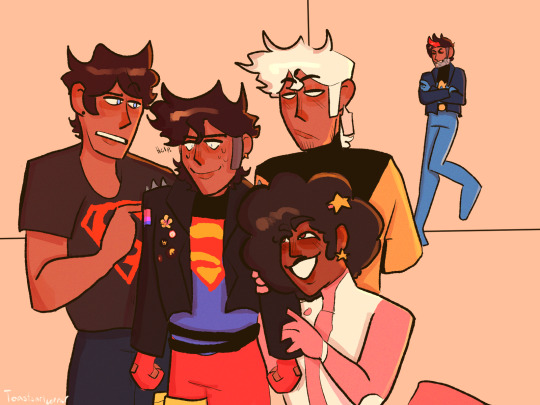
An AU where Kon saves and befriends his many clones ( + Travv)
Context and rambles are in the tags
#toasts art#Kon El#Match DC#Seraph DC#Travv DC#Clone shenanigans au#<- for potential future doodles#For clarification Match (SB94) and Match (T shirt variant) are two separate people specifically for this au#Listen every time Match shows up in the comics he is a whole different character in entirely. He is horrendously inconsistent#and I don't forgive Geoff Johns for just making him a different version of Bizzaro because Match in SB94 was pretty interesting to me#Travv is here too as honorary Kon clone#and so is Seraph because she might count more as a test tube baby come to think of it#DC is weird when it comes to clones because if you're going with the Clex clone retcon then Kon wouldn't be a clone either.#he'd be a tube baby#Anyway Kon is living with 4 clones and 3 of them might be plotting his downfall#I don't know who'd be interested in this au specifically#but I gotta learn to post self indulgent stuff sometimes
92 notes
·
View notes
Text

bro we are teens
#mikayuu#yuumika#mikaela hyakuya#yuuichirou hyakuya#owari no seraph#seraph of the end#keeperofthebox art#why is this the best drawing of them ive ever done and its just some random doodle. hello
402 notes
·
View notes
Text

hiii look at me i did art of my troll for once!! (even if its super sketchy)
taemins guilty challenge lives in my head..
mantri (he/she/they)
#seraphic art#mantri sarvia#homestuck#homestuck 2#hiveswap#fantrolls#guilty challenge#doodle#digital sketch#hs#hs2
81 notes
·
View notes
Text

Bungo Stray Dogs x Seraph of the End crossover AU!
[it came to me in a dream]
I came across MikaYuu for the first time in a while and got jumpscared by the "Semi Canon" tag on the fandom wiki and thus, in celebration, I read every chapter of the manga that I hadn't already, and boy is it gay!
So I decided to combine it with my current OTP as I noticed a lot of similarities between the two!! Possible new series/AU, perhaps? I sure am excited for it.
Here you have Jouno as Mika and Tecchou as Yuu
Reblog > Like
Do not repost without credit!!
Asks are open for this AU - You can look under the tag #Suegiku no Seraph on my profile for all the information on the AU
[This is the first post]
#suegiku no seraph#my art#drawing#fanart#illustration#doodle#bsd#art#bungo stray dogs season 4#bungo stray dogs#bungou stray dogs#sote#ons#owari no seraph#seraph of the end#mikayuu#suegiku#jouno#jouno bsd#jouno saigiku#tecchou#tetcho#tecchou suehiro#tecchou bsd#tetcho bsd#tetcho suehiro#crossover
167 notes
·
View notes
Text
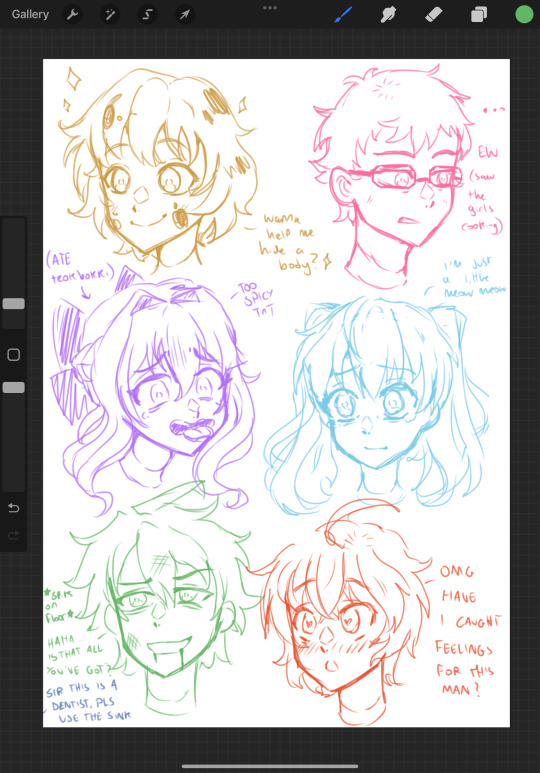
Expression practice (plus drawing guys practice too I guess XD) <3
#fanart#owari no seraph#seraph of the end#yoichi saotome#shiho kimizuki#shinoa hiragi#mitsuba sangu#yuuichirou hyakuya#mikaela hyakuya#digital art#my art#was in a doodling mood#scheduled post
43 notes
·
View notes
Text
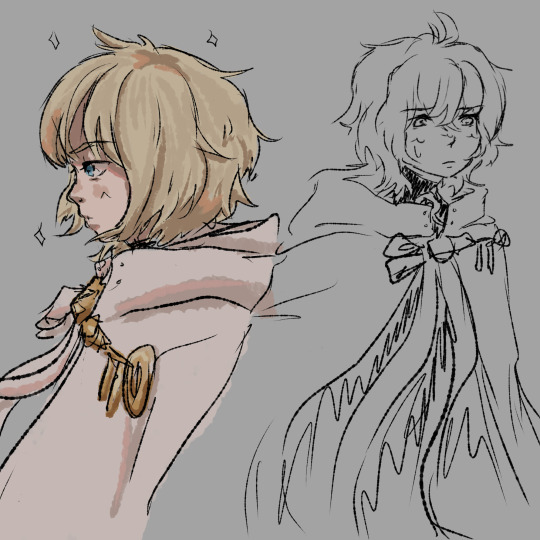
thing i did for a doodle trade on instagram (i have never watched seraph of the end)
#art#illustration#fanart#digital fanart#owari no seraph#seraph of the end#mikaela hyakuya#doodle#art trade
47 notes
·
View notes
Text


Seraph doodles with her parents and their...semi complicated relationship lol. This pair needs more love.
I haven't drawn her in so long she's such a cutie <3 didnt have the time to draw her glitches sadly
Yeah Fatal is having an absent father moment-
____
Fatal belongs to @fatal-error-blog
Lavender belongs to @naturetale-official
#undertale au#utmv#sanscest#oc#doodle#fatal error#lavender sans#fatal x lavender#seraph#cant wait to see fatal in 0.7 pt2#so hyped for that
63 notes
·
View notes
Text
Seraph!Ryou AU: Sometimes Ryou is too tired/depressed/just not in the mood to maintain a human form, and will shift back into being nothing but a mass of wings and eyes. His favorite place then is Yamima's lap to cuddle. (Still need to choose how I'm going to name Yamima in this AU)
Note that Ryou make himself just the right size for this. He can be way bigger if he wants too.
Yamima doesn't mind the extra fluff.
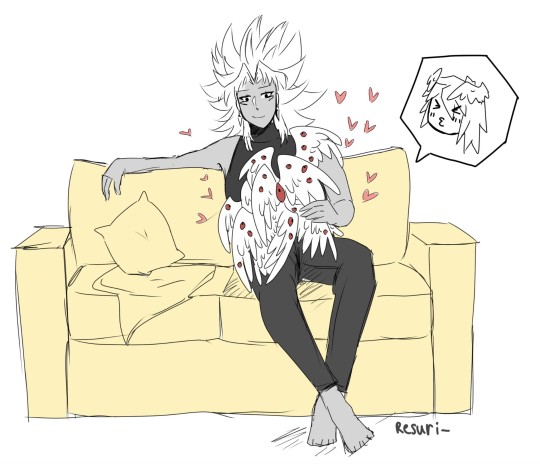
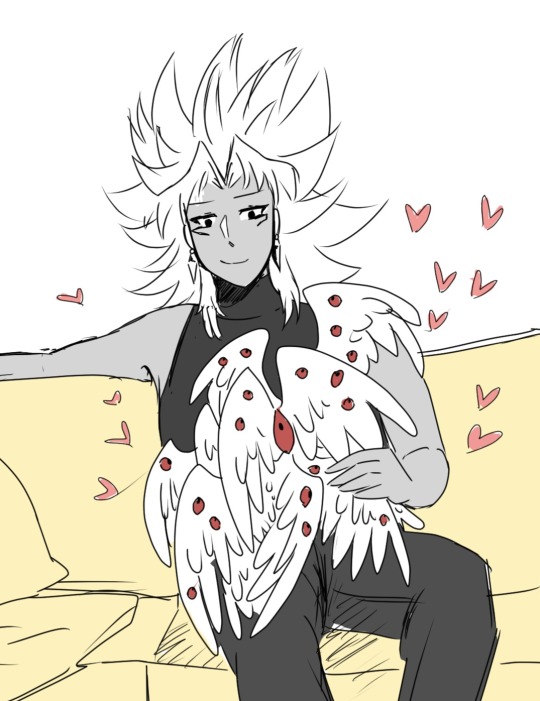
79 notes
·
View notes
Text
First oc post i am shaking crying throwing up for multiple reasons and also anxious as hell- anyways, meet the man, the failure disaster gay, the forever doomed ginger(derogatory/lh)


I forgot to add his birthday omg, it's march 13th
Lore utc (i wrote a lot lmao), the uh post ch 134 stuff will be elaborated on later (or if asked. Actually, ask me anything about him. And my other oc's once they're posted. Please. I will answer in great detail. I also need a distraction. Pls.)
So basically, among the first few vampires (a 4th progenitor to be percise) turned by Shikama was a woman who showed great potential for spells and magic. She had a loving husband and child which she tragically lost in an accident. Upon turning into a vampire, her family was still the only thing on her mind. She accepted to help Shikama in his endeavors to revive Mikaela since she hoped she could revive her own family in the proccess. Unfortunately it didn't work. Disillusioned, she abandoned vampire kind and started searching for the possible reincarnation of her beloved husband, whom she may be able to have a child with and have family again.
Fast forward a a lot, and I mean a lot, of years and she arrived in 60s japan. None of the people she had hope for turned out to be the reincarnation of her late husband until that fateful day. She encountered a (rather pathetic may I add) man in his late 20s and it was like a miracle. The woman cornered the man in disbelief and from this awkward first meeting blossomed true love. Then everything went to shit lmaooo
The first problem was that the mans family didn't approve of the woman. Tough this didn't stop their love. Next was the issue of bearing a child, something that a vampire simply can't do. Well, an ordinary one but this woman was anything but ordinary. By some impossible miracle she bore a child. A biological child. (GIRL HOW?? We will never know and frankly, i don't want to think about it💀)
The child was, as expected tbh, kind of a disaster. Already born with pointy ears and sharp fangs. The child needed both human food and blood to properly sustain themselves. Drinking blood outside of their family would permanently stop their aging. Despite this, the couple was overjoyed. (And then named their child "mistake" bc that would help /s.) They named him "Machigai". Why tho?? I dunno man something along the lines of "a mistake but the best mistake of their life" bruh
So after Machigai was old enough to walk, but not old enough to remember, the mother diappeared, leaving father and child behind. The father did his best to raise such an... extraordinary child but it was understandably kind of impossible. Machigai grew up alone and isolated from his peers. He was always wearing a hood of some kind and rarley opened his mouth to talk. In high school, he met a girl who he became good friends with but she is another oc I'll post about sometime adlf,wpl.
Anyways! Come Machigai's high school graduation and 18th birthday, his father... disappeared. All he left was a note saying, that Machigai now owned the apartment and that there is enough blood in the fridge to sustain Machigai's thrist while he could grow and mature. To an already depressed and disillusioned Machigai this obviously didn't help. Throughout the next years he became a shut in, who only left the house if absolutely necessary. All he did all day was play video games, watch tv and later be on the internet. Once he ran out of his fathers blood was when things changed. He had to go out and actually find a new source of blood. Welp, sorry to unlucky bastards who went into dark alleyways at night bc these types of people became Machigai's source of blood. (That's when he stopped aging)
On one of these nightly escapades, Machigai was greeted by a large man in a neat black suit who called himself "Saito". Saito claimed to have known Machigai's mother and offered a deal: Machigai would offer up his unique constitution to the Hyakuya sect's research and in turn get a well paying job and a guaranteed source of blood. He agreed. "Welcome to the Hyakuya sect. I look forward to your performance"
Machigai was practically a lab rat for the development of cursed gear. Thanks to his half-n-half physiology he could tank wounds from cursed gear/magic n shit while still providing useful data to how effective it is. During this time Machigai aquired knowledge of vampire culture(?), became familiar with magic and it's quirks and learned how to perform simple spells and whatnot.
Around 2011, when the internet was already fairly well used, Machigai came across a forum dedicated to paranormal sightings. Various users claimed that a secluded spot in Kyoto was home to vampires. (Ferid was the one spreading these rumors btw) Most would have dissmissed this as someone wanting attention, yet Machigai was intrigued. He was well aware that vampires existed across the world but he mever knew how to actually contact them. Perhaps out of morbid curiosity, perhaps out of a genuine want for connection with people like him, he went to check out the spot. There, he met none other than the eccentric Ferid Bathory who specifically manufactured the rumor to meet Machigai (extra much?). He was well aware of Machigai's work for Rígr "Saito" Stafford and was trying to one up his father by stealing his most prized lab-rat. Machigai declined, not trusting a single thing out of that vampires mouth. Ferid left, already proclaiming that one day Machigai would be working for him.
Machigai stuck around that area as it was already well into the night and public transport wouldn't start up until the early morning. There he met another vampire: Crowley Eusford. Their meeting wasn't planned or meticulously calculated, it was actually rather awkward. Their chat was meaningless and short but in the end leagues above whatever Ferid likes to plan. Crolwey has already unwillingly heard about this curious being from Ferid and seeing Machigai himself left him wanting to learn more about him. Machigai was left a little hopeful, that perhaps it's not too late for him to look for connections.
So the apocalypse rolls around-
Machigai makes a deal with Saito that in exchange for his freedom (*eagle screech*) he would keep his mouth shut about anything the Hyakuya sect discovered while Machigai was there.
Machigai seeks out the Demon Army where he successfully keeps his half vampire identity a secert until someone on his squad gets blackmailed into revealing it. Before that, he gets a cursed weapon, a pair of daggers. And lo and behold, the demon possessing the daggers is his own mother. Unfortunately since the now demonic mother didn't witness Machigai growing up, she falsey believes to be able to still shape Machiagi to her will. After getting locked up by the army, Machigai completley gives up, only wishing for his miserable existence to end (spoiler: It won't! Ever. :) ). He ultimately loses any and all trust he has in humanity or just anything in general.
After about half a year of grueling torture and some experimentation, Machigai gets freed (kidnapped) by Ferid and promptly brought to Kyoto Sangiuem. Krul Tepes, finding Machigai to be useful in her fake-ish war against humanity and whatever she's planning with Yuu and Mika, lets him be part of the japanese vampires under Ferids faction. Ferid found himself unwilling to deal with the often uncooperative and irritated new "recruit" so he did what he does best and made it Crowley's problem.
After a rather agressive and disrespectful first impression, Machigai was officially a... coworker? of Crowley and thus also Chess and Horn in Nagoya. The three got the additional task by Ferid to somehow domesticate this feral and angry stray animal and get him to open up. At least that's how Ferids orders were phrased. Shenanigans, Drama and FeelingsTM ensue.
(How did I write so much??)
#might be obvious but yes i am going down an oc x canon route with machigai amd crowley teehee#ahem ok so i should probably make a tag for my ocs#nono's ocs#there. wow. so creative.#otherwise i could have (and tbh i want to) elaborate on certain event's but this post is alr so long#i'm normal. so normal. if you search up the word normal you will see my picture#this is also huge coping with chapter 134 if you haven't noticed#most of the doodle page was actually done while i was in class#top student behavior amirite#enough rambling#owari no seraph#seraph of the end#crowley eusford#oc#original character#chess belle#horn skuld#ferid bathory#posting this took a solid week of wrestling with my anxiety#shit got hands
36 notes
·
View notes
Note
oh god, why did i read "miquella the unalloyed" as "miquella the UNEMPLOYED" 😭
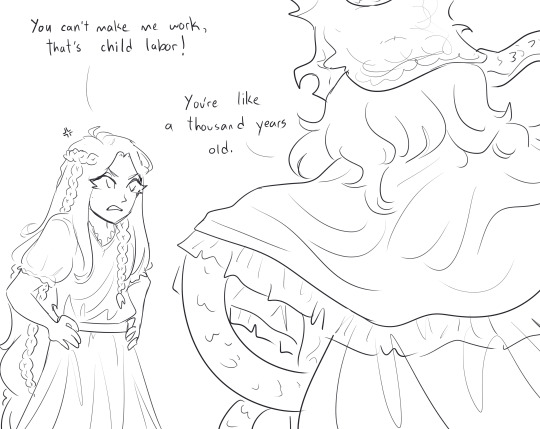
canon now
#my art#seraph doodles#ask#shitpost#er#soulsborne#elden ring#soulsbornering#miquella#messmer#miquella the unalloyed#messmer the impaler
430 notes
·
View notes
Photo


warmind au finale thingy
abhorrent imperative is all primed and ready from whoever was trying to fire it. idk a temujiin hack or willla or clovis buuuuut. kinda a combo of canon and bl dark future destiny 2?? where the traveler is running.
but the board as it is is probably the most stacked it’ll ever be!!! guardians wielding light and dark, a disciple slain, a growing alliance of species against the darkness... so the warminds out of fear that humanity won’t survive a second collapse (too much was lost the first time, who will be left?) and what has been built in riis decide to stop the traveler ras style again lol.
something something from an npc about retro rasputin repeating his mistakes but nah dude. ras has learnt real good!! now he’s shooting the traveler to save the eliksni and krills and caiatls ppl. it’s their war to win and man is rasputin ready to fucking win
357 notes
·
View notes
Text


seraph & cherub sketches
#my art#artists on tumblr#digital art#sketch#black and white#angel#angel art#seraph#cherub#pattern#mandala#doodle#wings#multiple eyes#rkgk#religious art#religious imagery
27 notes
·
View notes
Text
The Collective Seraphic Writing System
This post is going to be the one dedicated to explaining how the Seraphic writing system works. This writing system is entirely digital, as physical writing is no longer in everyday use throughout the Collective, so it's a bit inconvenient to actually write out. It's also weird to read, because it's written in a way that makes the assumption that you know how to speak and understand Seraphic, but I'll try to explain what I can.
Seraphic has two written forms: longform and shortform. Longform is used primarily to teach young instars how to read and write, and as a way to show how a shortform word is meant to be read. Shortform is the main form of writing, and due to its complication it's usually put off for a year or two before being taught in pupariums. Shortform is the method I'll be teaching today. It's primarily morpho-phonetic, with elements of both an alphabet and grammatical logograms, and is written bottom-to-top and right-to-left in reverse boustrophedon (the path of writing goes up, flips 180°, and goes back down). Because of this, you're expected to be able to read both right-side-up and upside-down. For this post, I'll be using an example sentence to highlight specifics areas of the writing system, as shown below:

It reads: nJasāğn k'œ̄nan ālxōr e-fya.
"There are 16 dull knives on the floor."
There are seven elements you need to be aware of when writing in Seraphic: the alphabet, class cartouches, procedural and plural ligatures, preposition glyphs, tone diacritics, numerals, and punctuation. I'll be going through each one step-by-step.
Alphabet

The alphabet makes up the majority of Seraphic writing. There are 30 consonants and 6 vowels, and they all arrange into syllable blocks called "cells". Each consonant takes one of three forms depending on if it is at the start of the syllable, before a vowel, or at the end of a syllable. The alphabet is featural, meaning that the way each letter is written is meant to encode its pronunciation. Here is the alphabet in full:

Each consonant (excluding the ejectives) showcases the three variant forms it can take (similar to capital and lowercase letters in the latin alphabet). The largest, leftmost character is the form that hosts the interior vowels within it. The rightmost vertical form is used when preceeding another consonant, and the upmost horizontal form is used at the end of syllables. If a syllable contains a syllablic consonant, the main consonant will have no vowel within it and instead a syllable-final form of one of the syllabic consonants (r, l, m, n, or ŋ) placed on top of it.

Concerning vowels, they are solely meant to be written within consonants, acting sort of like internal diacritics. They cannot exist on their own, nor can more than one be written within the same consonant (Seraphic doesn't allow diphthongs), and if a vowel must be written by itself it is written within the glottal stop letter ' (in this instance acting as an independant vowel holder).

These rules apply to individual syllables. In multi-syllabic words, each syllable cell is arranged together in a specific way based on the number of syllables in order to keep the line uniform and compact.
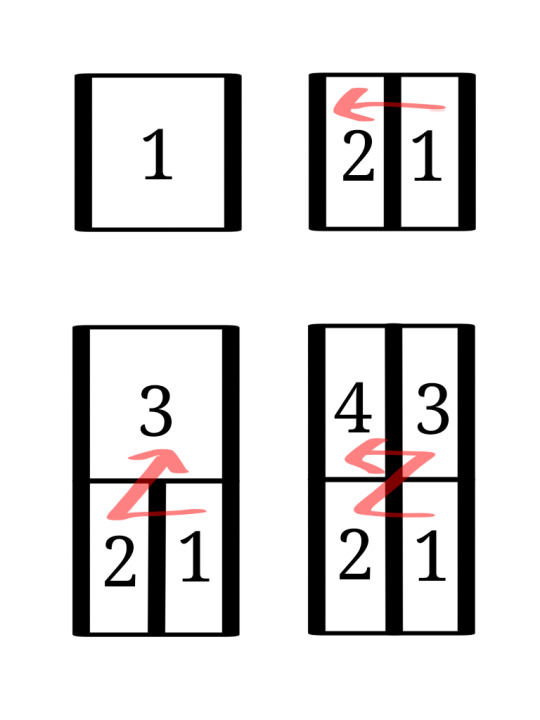
the flow of reading word-internally definitely follows the overall direction of writing (bottom-to-top, right-to-left) so broken down an entire word will usually look like this when written:

Seraphic written in longform will be written entirely using the alphabet. Spaces are put between words, punctuation and numeral symbols are still used, and tone diacritics may be included as well, but otherwise it's entirely spelled out in this way. Writing this way makes the text as a whole quite longer, and can come off as childish or imply you're a new learner of Seraphic, so shortform will usually be used in official contexts. In shortform, alphabetical letters are restricted to non-declined parts of nouns, adjectives, and proper nouns.
Class Cartouches

In Seraphic, there are seven noun classes: Solar (people), Astral (animals), Vital (plants), Terranean (places), Metallic (objects), Lunar (concepts), and Oceanic (everything else). Similarly, the writing system employs seven symbols called "class cartouches" to encode which noun class a word is in. This is drawn from this writing system's predecessor, the Aeonic Seraphic alphabet, that also used glyphs to notate class. These are the seven noun class cartouches:
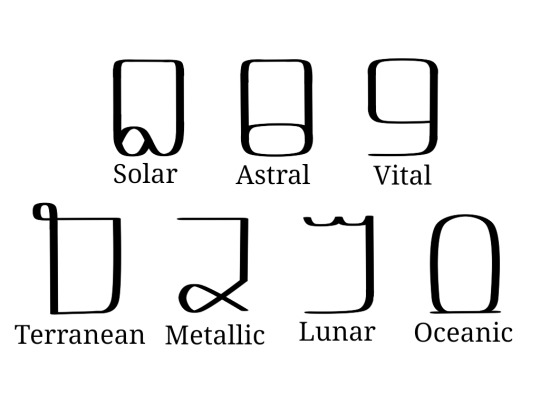
The thing about the class cartouches is, not only is it morphological, but it's also phonetic. A noun is never spelled out in its entirety, usually only part of it is. When a class cartouche is used, it's supposed to stand in for the class prefix itself without having to additionally spell the class prefix in the rest of the word. For example, in the word zājlux (tail), the "-jlux" would be spelled out, and the solar class cartouche would be drawn around it to stand in for the "zā-". Even though you don't write it, you still know it's there because of the class cartouche. Because of the nature of the noun class prefixes, and how many different forms they can take, it can be daunting to have to guess if you're supposed to pronounce a word with a "za-" or a "zo-", but there are patterns to which prefix (and thus, declension patterns), is meant to be read depending on what the following sound is.
Solar class
read as zā before f, v, s, z, c, j, pf, ts, tc and any cluster of two consonants (e.g. zāsā, zāfr, zājlux)
read as zō before x, ğ, h, ', and kx (e.g. zōxō, zōxur, zōğœcl)
read as zē in stressed syllables, and occasionally before consonant clusters (e.g. zēzmp'ux, zēzt'e, zēvasax)
read as s before vocalics (vowels and syllabic consonants), r, l, w, y, n, t, d, p', or k' (e.g. srāc, sēr, sōğœc)
read as ts before t', the ts replacing the t' entirely in pronunciation, for example tsn would be written as (Solar)t'n (e.g. tsn, tsā, tsłzaf)
Astral class
read as ğr before f, v, s, z, c, j, x, ğ, h, pf, ts, tc, kx, p', t', k' and and cluster of two consonants (e.g. ğrzles, ğrxur)
read as x before vocalics, r, l, w, y, ŋ, k, g, p', or t' (e.g. xūc, xŋox)
read as kx before k', the kx replacing k' in pronunciation (e.g. kxa)
Vital class
read as wā before r, l, w, or y (e.g. wāya, wārāc, wāwax)
read as wō before k', k, g, x, ğ, ŋ, or kx (e.g. wōk'ł, wōxur, wō'ōf)
read as wē before consonant clusters (e.g. wēzles, wējlux, wējlozln)
read as ū before n, m, p', p, b t', t, d, f, v, s, z, c, j, pf, ts, or tc (e.g. ūt'u, ūp'n)
read as w before vocalics (e.g. wē, wīn, wājr)
read as wī occasionally before consonant clusters (e.g. wīzya)
Terranean class
read as va before f, v, s, z, c, j, pf, ts, tc and any cluster of two consonants (e.g. vafl, vasērn, vasa)
read as vo before x, ğ, h, ', kx, and consonant clusters (e.g. voxāl, vodsā, vojrayux)
read as vu in stressed syllables and occasionally before consonant clusters (e.g. vujlux, vulvren, vuzajni)
read as f before vocalics, r, l, y, w, m, n, ŋ, p, b, t', or k' (e.g. fe, fruvn, fmağo)
read as pf before p', pf replacing p' in pronunciation (e.g. pfan)
Metallic class
read as ja before f, v, s, z, c, j, pf, ts, tc and any cluster of two consonants (e.g. jafa, javlni, jawaya)
read as jo before x, ğ, h, ', and kx (e.g. joxl)
read as c before vocalics, r, l, w, y, n, t, d, p', or t' (e.g. can, cya, cenaŋx)
read as tc before t', the tc replacing the t' entirely in pronunciation (e.g. tcłvr, tcāŋğl, tcū)
Lunar class
read as la before r, l, w, or y (e.g. lara, layeğr, lalel)
read as lo before k', k, g, x, ğ, ŋ, or kx (e.g. loxir, loğn̄, loxel)
read as le before consonant clusters (e.g. levp'ā, levren, lejt'ān)
read as li in stressed syllables and occasionally before consonant clusters (e.g. liwayi, lit'n̄, livasāx)
read as y before vocalics (e.g. yar, yu, yawu)
read as l/ł before n, m, p', p, b t', t, d, f, v, s, z, c, j, pf, ts, or tc (e.g. lce, łzēwok'u, lvulvren)
Oceanic class
read as a/ā before m, n, p', p, b, t', t, d, s, z, f, v, c, j, pf, ts, tc, w, r, y, l, and all consonant clusters (e.g. ap'i, āt'ē, ācèya)
read as o/ō before ŋ, k', k, g, ', x, ğ, h, and kx (e.g. ōxūr, ōxān)
read as aw/āw before vocalics (e.g. awun, awaf, awaman)
Of course these rules are not hard set, and there are several instances where a written word contradicts these rules or even when two words end up spelled the same, but for the most part these rules will generally be consistent for most written words. It seems like a lot to remember, but usually it's a thing that you eventually develop a sort of "ear" for.

Procedural and Plural Ligatures

The procedural and plural ligatures are additional glyphs used to mark, respectively, the procedurals and the plurals of a noun. The procedural are written at the bottom of the noun (since Seraph is written bottom-to-top and these are prefixes of course), and there are 12 separate procedural symbols in use. Similarly, the plurals, being suffixes, are written at the top of the noun and contain only three symbols (the singular is usually unmarked). They are as follows:
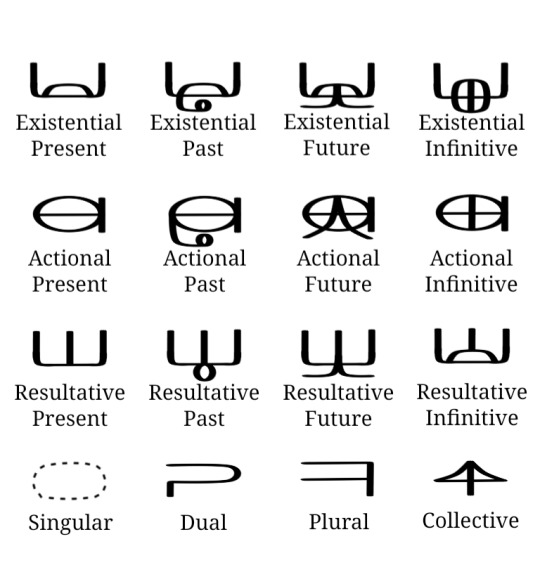
The plural ligatures attach to both nouns and adjectives freely, but in order for a procedural ligature to attach to an adjective, the adjective needs to be put in the oceanic class and subsequently written with the oceanic class cartouche. Additionally, if you want to write remote past/future forms for each procedural, you would need to attach the resultative present ligature underneath the preexisting past or future ligature (these conjugations haven't developed their own separate ligature forms, so they follow the tradition of using the resultative in addition as semantically that is where the remote forms originated). I don't really have a way to show you how to pronounce the plural forms, as even though the different pronunciations are pretty few they're actually pretty inconsistent on which one goes where. It's just one of those things you kinda have to already know. You can check the introduction to Seraphic post to see what forms the plurals can take, but otherwise it's basically, like, memorization. The procedurals on the other hand DO have a predictable pattern of pronunciation, but each tense has a different form based on what class and declension the noun is in, and with six tenses and seven classes each with at least three different declension forms, it's definitely something I can't summarize here. Again I HAVE to make a separate post for that because the declension forms are vital to knowing how to decline properly in Seraphic.
Preposition Glyphs

This section will probably be the easiest to explain really. The preposition glyphs are pretty easy to recognize. They're written in between words, attaching to both of them instead of floating freely like regular words are. There are 19 glyphs for the 19 prepositions, and they don't really change form. Sometimes, if occurring at the beginning of a sentence, they'll have one end sorta lopped off, but not everyone follows through with this convention. Here are the glyphs listed below:
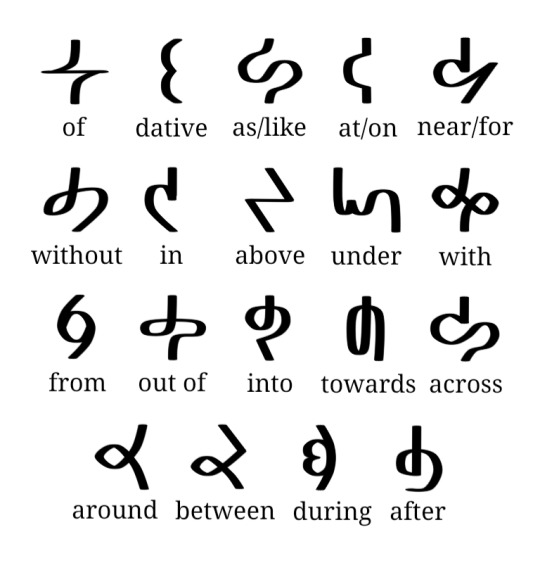
Two or more prepositions can't occur sequentially, it's a very one-at-a-time situation, although in colloquial speech you'll see two prepositions being used in certain instances.
Tone Diacritics

Seraphic is a tonal language, and luckily it has diacritics to indicate the tones. They frame the words on each size, being used on both nouns and adjectives where applicable. You'll usually see them in formal contexts like government documents and letters of address, on signs and boards and menus and any kind of display especially in highly populated areas, in use by those whom are just learning Seraphic and don't have a hang on remembering all of the tones yet, and just in any context where clarity of literacy would be important. In everyday colloquial text conversations and things the tone diacritics will be usually dropped as context is sufficient enough to know, although tone diacritics may be reintroduced to differentiate homonyms that are distinguished only in tone (e.g. lxal "power" vs. łxāl "day"). There are eight individually recognized tone diacritics:

The low tone is the base tone and is usually left unmarked, so there's no sign for just the low tone. When a low tone transitions to a rising or falling though, the low transition diacritic will be used to connect the two. Many of these diacritics are usually connected consecutively when a word requires it, flowing as if they're one larger tone diacritic. This can give a whole host of unique tone symbols, but for the most part, all of the tone symbols can be broken down officially into the 8 diacritics. There isn't a 1-1 correspondence between individual tone diacritics and syllables within a word, usually you can know from context and just knowing how the word is pronounced. For example, the word łxāl would be written with one high tone marker even though the word is two syllables, but it's meant to infer that the entire word is pronounced with an even high tone. Here are some additional examples:
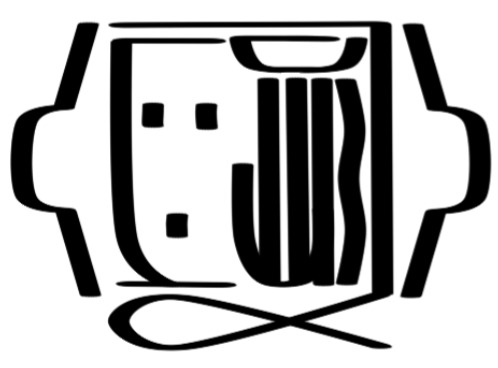
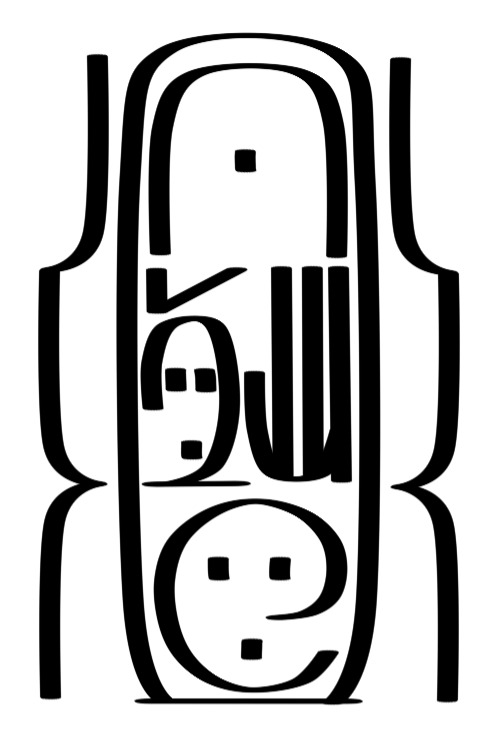
The top example is the word jalzègxa "chronicle". You can see that it uses the two low tone transitions to connect to the central falling tone, representing a low-falling-low relationship. The word below that is māzefādnu "hourglass". It employs a high-low-high, and then a high-low, with the last high-low meant to merge with the high-low-high. So truthfully it's meant to be interpreted as high-low-high-low. There's a lot of possibilities, but breaking it down will simplify what tones are being used specifically.
Numerals and Punctuation

This final section will discuss Seraphic numerals and punctuation. Now, unlike in most human languages which uses base-10, having 10 unique symbols to represent the values of 0-9, Seraphic uses base-16 and represents the values 1-16 with 16 individual symbols. In base 16, we would write 16 as 10, standing for one set of 16 and zero sets of 1. It's written in positional notation like arabic numerals, where each position represents a power of 16 (instead of a power of ten like in base-10). Here are the numerals:
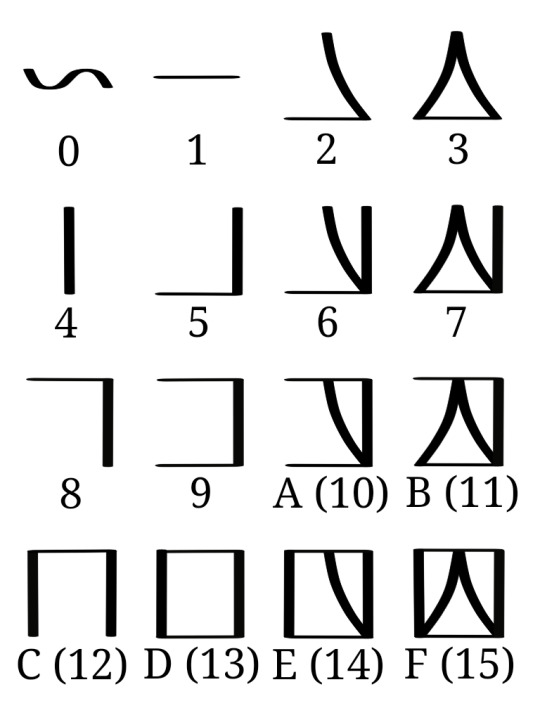
If you were to write a number like 299,792,458; you'd convert it into base-16 which would be 11,DE7,84A; and since Seraphic numerals are grouped in 4 instead of 3 it would actually be 11DE,784A. This is how you'd write that:
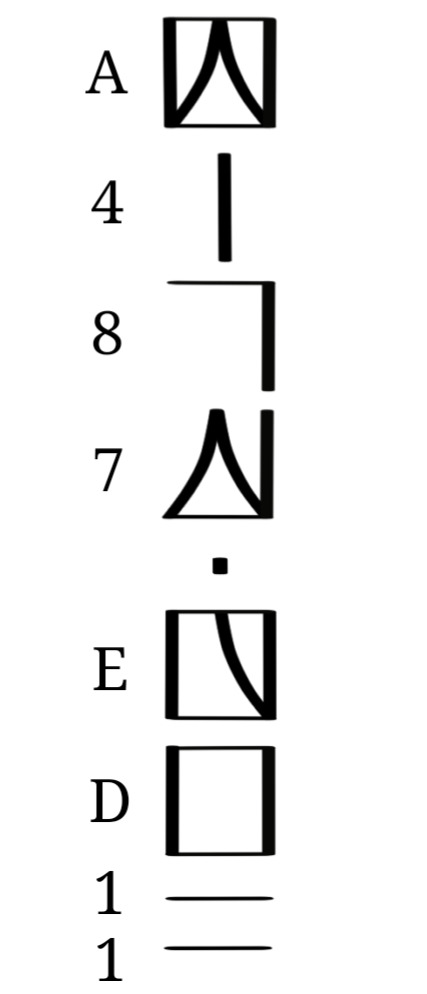
Both Arabic numerals and Seraphic numerals describe the same amount of things, they just group things differently. We group in sets of 10, they group in sets of 16.
As for punctuation, there are only 5 marks that's in standard use, and these are them:
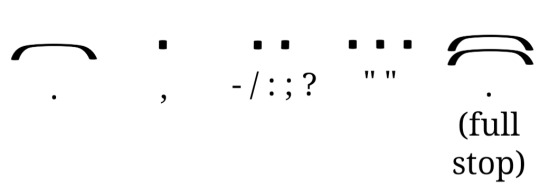
Single bar - separates individual sentences.
Single dot - separates clauses for clarity, separates numerals into groups of four.
Double dot - separates individual words such as in lists or replaces a single dot when separating clause groups.
Triple dot - Distinguishes quotes and dialogue, as well as highlighting names, terms, and titles.
Double bar - used to end full paragraphs/passages instead of a single bar.
Overall, that's pretty much everything I can detail about how the Seraphic writing system works! It's complicated but it was very fun to develop and boy was it satisfying to get it to work. Hopefully you'll now be able to decode a little better Seraphic writing, and maybe even write something of your own!

ŋKowīci cu-stux 'ōf tsa-levp'ā cu-zāsláf pi-lizt'n ğōdjasa! (Thank you all so much for reading!)
#conscript#constructed script#neography#conlang#constructed language#artlang#writing system#orthography#seraphic#collective seraphic#whoa boy this one is even longer#had to do a lot of writing and doodles for this#of course i needed them so itd all make sense#i needed to provide examples#either way i hope this made any sort of sense#ill provide the declension forms soon enough and that should be relatively shorter#idk if it'll be easier to explain though#eh whatever
44 notes
·
View notes
Text
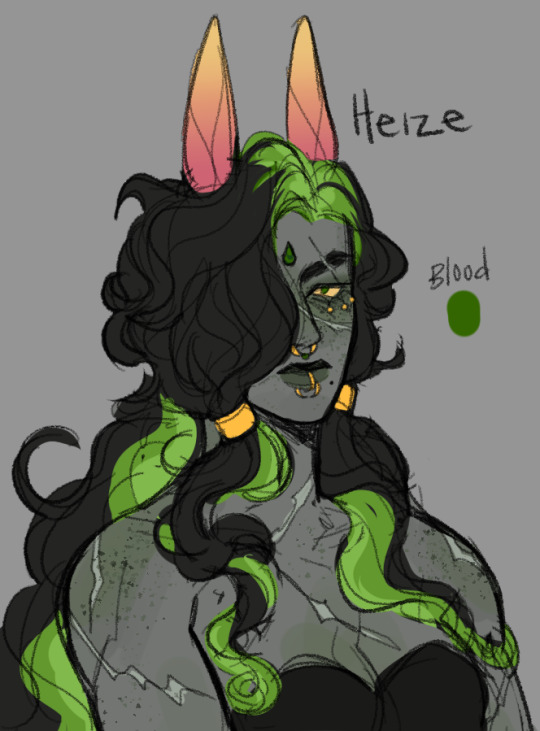

two more I found while digging around in my files.. I don't? think I posted them before either.. but more of my trolls!! this time it's heize and litchi!! :D
(litchi was designed by @/lunchboxtrolls !!)
#seraphic art#litchi mimosa#heize atham#homestuck#fantroll#hs#hiveswap#digital art#doodle#SNNF SNNORF I LOVE UR DEISGNS KIWI
38 notes
·
View notes